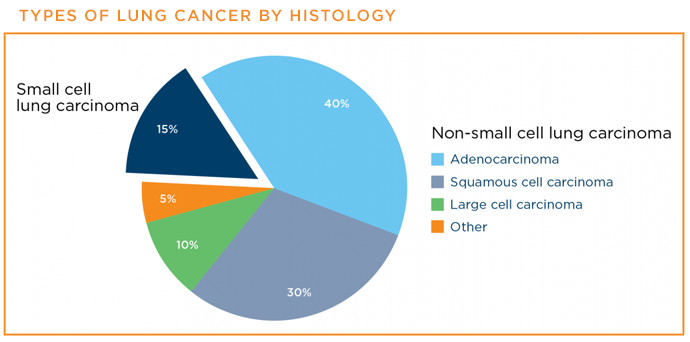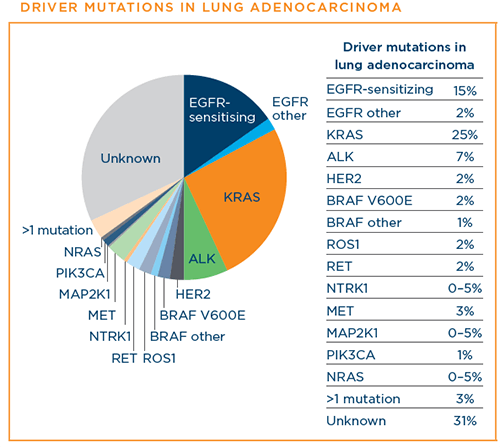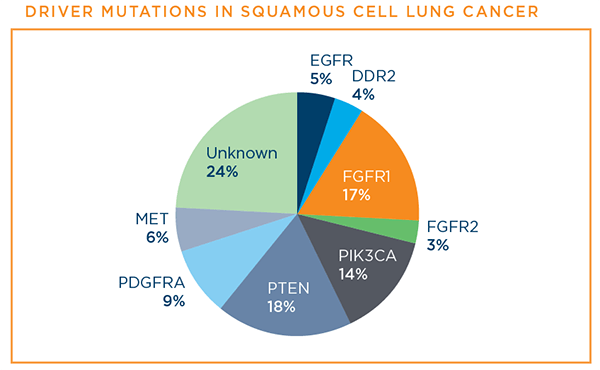What are the different types of lung cancer? How is lung cancer classified?
Lung cancer can be classified in two ways, either by its histology (what the cells look like under a microscope) or by its biomarkers (genes or proteins whose activity becomes altered in cancer).
Because each type of lung cancer behaves and is treated differently, it helps to have as much information as possible about a person’s individual lung cancer. To get that information, a pulmonologist or surgeon should provide samples of the tumor from a biopsy to a pathologist. Having a pathologist who is experienced in looking at lung cancer will provide the most accurate information.
Classifying lung cancer by histology
The different types of lung cancer are described histologically by the types of cells the pathologist sees under the microscope. About 85% of lung cancers are non-small cell lung cancer (NSCLC) and about 15% are small cell lung cancer (SCLC).1,2
There are three major types of NSCLC:
- Lung adenocarcinoma
- Squamous cell lung cancer (also called epidermoid carcinoma)
- Large cell lung cancer
More information on each of these types is available on separate pages on this website.

Classifying lung cancer by biomarkers
Lung cancer is a complex disease that not only is classified by cell type, but also can be divided further by mutation—the changes to the cell that allowed the cancer to grow. Each type of lung cancer may or may not have one of the mutations. So far, researchers have identified a number of different mutations, called driver mutations, that can lead to lung cancer, and they are continuing to look for more. To date, there has been the most progress in understanding adenocarcinoma driver mutations, but scientists are also learning about squamous cell and small cell driver mutations.1-3
NSCLC – Adenocarcinoma
Lung adenocarcinoma makes up about 40% of NSCLC cases. See more information on lung adenocarcinoma, how it is diagnosed, and current treatments.
Researchers have made great progress in identifying and understanding “driver mutations” in NSCLC adenocarcinoma, which has resulted in a number of targeted therapies, a very precise type of cancer treatment that identifies and attacks specific parts of cancer cells and the signals that proteins send to cancer cells that cause them to grow and divide uncontrollably.4
Genes with driver mutations for which there are FDA-approved targeted therapies for the treatment of lung cancer are listed below. Learn more about approved targeted therapies for each mutation.
- ALK
- BRAF V600E
- EGFR (including mutations not sensitive to tyrosine kinase inhibitors)
- HER2
- KRAS
- MET exon 14 skipping
- NTRK
- RET
- ROS1

NSCLC – Squamous Cell Lung Cancer
Squamous lung cancer accounts for approximately 30% of NSCLC cases. See more information about squamous cell lung cancer, including how it is diagnosed and current treatments.
Our understanding of driver mutations is not as advanced for squamous cell lung cancer as it is for lung adenocarcinoma. However, a number of mutations have been identified, and researchers are working to better understand the role of these mutations in order to develop effective treatments for this NSCLC subtype.

NSCLC – Large Cell Lung Cancer
Large cell lung cancer is the least common NSCLC subtype, accounting for a small percentage of cases. See more information on large cell lung cancer, including how it is diagnosed and current treatments.
How Do I Know if I Have a Mutation?
Comprehensive biomarker testing is used among patients diagnosed with lung cancer to determine the presence of particular mutations or of a particular protein. It is the first step in precision medicine—ensuring that a patient gets matched to the right treatment at the right time, based on the patient's biomarker status.
Biomarker testing may be appropriate:
- When the doctors suspect lung cancer and have recommended a biopsy
- When a patient is already diagnosed with lung cancer
- When a patient's lung cancer recurs (comes back) after treatment
All patients with a lung cancer diagnosis should discuss biomarker testing with their healthcare team.
To find out whether a targeted therapy or immunotherapy may be a good therapeutic option for a patient who has been diagnosed with lung cancer, that patient's tumor tissue or blood can be tested for the presence of driver mutations. The tumor tissue can also be tested for the PD-L1 protein.
Biomarker testing should be an ongoing part of the discussion with a patient's healthcare team. Any decision to test for biomarkers should be made together and will depend on a number of factors, including the patient's type and stage of lung cancer, current treatment plan, overall health, and preferences.
Learn more about biomarker testing.
What if I Don’t Have a Mutation/Biomarker?
Some people diagnosed with lung cancer will discover that they don’t have a currently actionable driver mutation or biomarker. It is important to recognize that lung cancer research has made incredible progress in recent years, and many new mutations/biomarkers have been identified. It is possible that additional biomarkers will be found in the near future that lead to promising new clinical trials or new treatment options. Knowing the makeup of your particular type of lung cancer gives your care team the opportunity to provide you the best possible treatment.
References
- What is Non-Small Cell Lung Cancer? American Cancer Society website. https://www.cancer.org/cancer/non-small-cell-lung-cancer/about/what-is-non-small-cell-lung-cancer.html. Updated November 20, 2023. Accessed February 5, 2024.
- Wistuba I, Brambilla E, Noguchi M. Chapter 17: Classic Anatomic Pathology and Lung Cancer. In: Pass HI, Ball D, Scagliotti GV, eds. IASLC Thoracic Oncology, Second Edition. Philadelphia, PA: Elsevier; 2018:143-146. Accessed February 5, 2024.
- Hirsch FR, Suda K, Wiens J, Bunn PA Jr. New and emerging targeted treatments in advanced non-small cell lung cancer. Lancet. Sep 3 2016; 388(10048)L1012-1024. https://pubmed.ncbi.nlm.nih.gov/27598681/. Accessed February 5, 2024.
- Cancer Genome Atlas Research Network. Comprehensive genomic characterization of squamous cell lung cancer. Nature. Sep 27 2012; 489(7417): 519-525. https://www.nature.com/articles/nature11404. Accessed February 5, 2024.
- Perez-Moreno P, Brambilla E, Thomas R, Soria JC. Squamous cell carcinoma of the lung: molecular subtypes and therapeutic opportunities. Clinical Cancer Research. May 1 2012; 18(9): 2443-2451. https://www.researchgate.net/profile/Pablo_Perez-Moreno/publication/221693814_Squamous_Cell_Carcinoma_of_the_Lung_Molecular_Subtypes_and_Therapeutic_O.... Accessed February 5, 2024.
